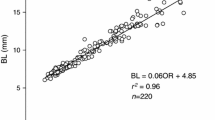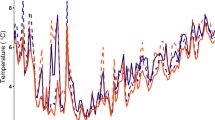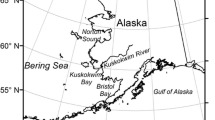Abstract
Seasonal energy allocation and deficits of marine juvenile fishes have considerable effects on their survival. To explore the winter survival mechanism of marine fishes with low lipid reserves in their early life, juvenile walleye pollock Theragra chalcogramma were collected along the continental shelf of northern Japan over a 2-year period, and energy allocation and deficit patterns were compared between wild and laboratory-starved fish. Contrary to expectations, wild fish generally continued to accumulate protein mass and concurrently tended to reduce lipid mass from late autumn through winter. The most plausible explanation for the continuous structural growth is that juvenile pollock give priority to reducing mortality risk from size-selective predators under quasi-prey-limited conditions. Exceptionally, inshore small fish reduced both constituents during a winter. The inshore fish consumed 2.5 times more lipid energy than protein energy in November–December, but protein was more important than lipids as a source of energy in December–January and in February–March. However, dependence upon protein reserves was lower for the wild fish than for the laboratory-starved fish, suggesting milder nutritional stress of the wild fish than that observed in the starvation experiment. Moreover, the lipid contents of mortalities in the starvation experiment were mostly <1%, whereas few wild fish had such lipid contents in the field. These results suggest that juvenile pollock are able to avoid both starvation and predation by accumulating protein reserves.








Similar content being viewed by others
References
Álvarez D, Nicieza AG (2005) Compensatory response ‘defends’ energy levels but not growth trajectories in brown trout, Salmo trutta L. Proc R Soc B 272:601–607. doi:10.1098/rspb.2004.2291
Anthony JA, Roby DD, Turco KR (2000) Lipid content and energy density of forage fishes from the northern Gulf of Alaska. J Exp Mar Biol Ecol 248:53–78. doi:10.1016/S0022-0981(00)00159-3
Biro PA, Morton AE, Post JR, Parkinson EA (2004) Over-winter lipid depletion and mortality of age-0 rainbow trout (Oncorhynchus mykiss). Can J Fish Aquat Sci 61:1513–1519. doi:10.1139/F04-083
Brodeur RD (1998) Prey selection by age-0 walleye pollock, Theragra chalcogramma, in nearshore waters of Gulf of Alaska. Environ Biol Fish 51:175–186
Brodeur RD, Wilson MT (1996) A review of the distribution, ecology and population dynamics of age-0 walleye pollock in the Gulf of Alaska. Fish Oceanogr 5(Suppl 1):148–166
Brown JA, Pepin P, Methven DA, Somerton DC (1989) The feeding, growth and behaviour of juvenile cod, Gadus morhua L., in cold environments. J Fish Biol 35:373–380
Castellini MA, Rea LD (1992) The biochemistry of natural fasting at its limits. Experientia 48:575–582
Caulton MS, Bursell E (1977) The relationship between changes in condition and body composition in young Tilapia rendalli Boulenger. J Fish Biol 11:143–150
Ciannelli L, Brodeur RD, Buckley TW (1998) Development and application of a bioenergetics model for juvenile walleye pollock. J Fish Biol 52:879–898
Ciannelli L, Brodeur RD, Napp JM (2004) Foraging impact on zooplankton by age-0 walleye pollock (Theragra chalcogramma) around a front in the southeast Bering Sea. Mar Biol 144:515–526. doi:10.1007/s00227-003-1215-4
Copeman LA, Parrish CC, Gregory RS, Wells JS (2008) Decreased lipid storage in juvenile Atlantic cod (Gadus morhua) during settlement in cold-water eelgrass habitat. Mar Biol 154:823–832. doi:10.1007/s00227-008-0975-2
FAO (2009) The state of world fisheries and aquaculture 2008. Electronic Publishing Policy and Support Branch Communication Division FAO. http://www.fao.org/docrep/011/i0250e/i0250e00.htm. Accessed 17 September 2009
Garvey JE, Ostrand KG, Wahl DH (2004) Energetics, predation, and ration affect size-dependent growth and mortality of fish during winter. Ecology 85:2860–2871
Gibney MJ, Macdonald IA, Roche HM (2003) Nutrition and metabolism. Blackwell, Oxford
Harris RK, Nishiyama T, Paul AJ (1986) Carbon, nitrogen and caloric content of eggs, larvae, and juveniles of the walleye pollock, Theragra chalcogramma. J Fish Biol 29:87–98
Hatch SA, Sanger GA (1992) Puffins as samplers of juvenile pollock and other forage fish in the Gulf of Alaska. Mar Ecol Prog Ser 80:1–14
Heintz RA, Vollenweider JJ (2010) Influence of size on the sources of energy consumed by overwintering walleye pollock (Theragra chalcogramma). J Exp Mar Biol Ecol 393:43–50. doi:10.1016/j.jembe.2010.06.030
Hervant F, Mathieu J, Durand J (2001) Behavioural, physiological and metabolic responses to long-term starvation and refeeding in a blind cave-dwelling (Proteus anguinus) and a surface-dwelling (Euproctus asper) salamander. J Exp Biol 204:269–281
Honda S (2004) Abundance estimation of the young cohorts of the Japanese Pacific population of walleye pollock (Theragra chalcogramma) by acoustic surveys. Bull Fish Res Agen 12:25–126
Honda S, Oshima T, Nishimura A, Hattori T (2004) Movement of juvenile walleye pollock, Theragra chalcogramma, from a spawning ground to a nursery ground along the Pacific coast of Hokkaido, Japan. Fish Oceanogr 13(Suppl 1):84–98
Hurst TP (2007) Causes and consequences of winter mortality in fishes. J Fish Biol 71:315–345. doi:10.1111/j.1095-8649.2007.01596.x
Hurst TP, Conover DO (1998) Winter mortality of young-of-the-year Hudson River striped bass (Morone saxatilis): size-dependent patterns and effects on recruitment. Can J Fish Aquat Sci 55:1122–1130
Hurst TP, Conover DO (2003) Seasonal and interannual variation in the allometry of energy allocation in juvenile striped bass. Ecology 84:3360–3369
Johnson TB, Evans DO (1990) Size-dependent winter mortality of young-of-the-year white perch: climate warming and invasion of the Laurentian Great Lakes. Trans Am Fish Soc 119:301–313
Kasai H, Saito H, Kashiwai M, Taneda T, Kusaka A, Kawasaki Y, Kono T, Taguchi S, Tsuda A (2001) Seasonal and interannual variations in nutrients and plankton in the Oyashio region: a summary of a 10-years observation along the A-line. Bull Hokkaido Natl Fish Res Inst 65:55–134
Kooka K, Yamamura O, Andoh T (2007a) Rate of energy depletion and overwintering mortality of juvenile walleye pollock in cold water. J Fish Biol 71:1714–1734. doi:10.1111/j.1095-8649.2007.01638.x
Kooka K, Yamamura O, Nishimura A, Hamatsu T, Yanagimoto T (2007b) Optimum temperature for growth of juvenile walleye pollock Theragra chalcogramma. J Exp Mar Biol Ecol 347:69–76. doi:10.1016/j.jembe.2007.03.003
Kooka K, Yamamura O, Ohkubo N, Honda S (2009) Winter lipid depletion of juvenile walleye pollock Theragra chalcogramma in the Doto area, northern Japan. J Fish Biol 75:186–202. doi:10.1111/j.1095-8649.2009.02279.x
Lankford TE Jr, Billerbeck JM, Conover DO (2001) Evolution of intrinsic growth and energy acquisition rates. II. Trade-offs with vulnerability to predation in Menidia menidia. Evolution 55:1873–1881
Méndez G, Wieser W (1993) Metabolic responses to food deprivation and refeeding in juveniles of Rutilus rutilus (Teleostei: Cyprinidae). Environ Biol Fish 36:73–81
Metcalfe NB, Thorpe JE (1992) Anorexia and defended energy levels in over-wintering juvenile salmon. J Anim Ecol 61:175–181
Miyake H, Yoshida H, Ueda Y (1996) Distribution and abundance of age-0 juvenile walleye pollock, Theragra chalcogramma, along the Pacific coast of southeastern Hokkaido, Japan. NOAA Tech Rep NMFS 126:3–10
Molony BW (1993) Effects of feeding history on mobilisation and deposition of body constituents and on growth in juvenile Ambassis vachelli (Pisces: Chandidae). Mar Biol 116:389–397
Niimi AJ (1972) Changes in the proximate body composition of largemouth bass (Micropterus salmoides) with starvation. Can J Zool 50:815–819
Nishimura A, Hamatsu T, Shida O, Mihara I, Mutoh T (2007) Interannual variability in hatching period and early growth of juvenile walleye pollock, Theragra chalcogramma, in the Pacific coastal area of Hoddaido. Fish Oceanogr 16:229–239. doi:10.1111/j.1365-2419.2006.00428.x
Paul AJ (1986) Respiration of juvenile pollock, Theragra chalcogramma (Pallas), relative to body size and temperature. J Exp Mar Biol Ecol 97:287–293
Saito H, Kasai H, Kashiwai M, Kawasaki Y, Kono T, Taguchi S, Tsuda A (1998) General description of seasonal variations in nutrients, chlorophyll a, and netplankton biomass along the A-line transect, western subarctic Pacific, from 1990 to 1994. Bull Hokkaido Natl Fish Res Inst 62:1–62
SAS (2005) JMP user guide, release 6. SAS Institute Inc, Cary
Scheiner SM, Gurevitch J (2001) Design and analysis of ecological experiments, 2nd edn. Oxford University Press, New York
Shida O (2002) Age-dependent bathymetric pattern of walleye pollock, Theragra chalcogramma, off the Pacific coast of eastern Hokkaido. Sci Rep Hokkaido Fish Exp Stn 63:9–19
Smith RL, Paul AJ, Paul JM (1986) Effect of food intake and temperature on growth and conversion efficiency of juvenile walleye pollock (Theragra chalcogramma (Pallas)): a laboratory study. J Cons Int Explor Mer 42:241–253
Sogard SM, Olla BL (2000) Endurance of simulated winter conditions by age-0 walleye pollock: effects of body size, water temperature and energy stores. J Fish Biol 56:1–21
Springer AM (1992) A review: walleye pollock in the North Pacific—how much difference do they really make? Fish Oceanogr 1:80–96
Van Pelt TI, Piatt JF, Lance BK, Roby DD (1997) Proximate composition and energy density of some North Pacific forage fishes. Comp Biochem Physiol A 118:1393–1398
Weatherley AH, Gill HS (1987) The biology of fish growth. Academic, London
Yamamura O (2004) Trophodynamic modeling of walleye pollock (Theragra chalcogramma) in the Doto area, northern Japan: model description and baseline simulations. Fish Oceanogr 13(Suppl 1):138–154
Yamamura O, Yabuki K, Shida O, Watanabe K, Honda S (2001) Spring cannibalism on 1 year walleye pollock in the Doto area, northern Japan: is it density dependent? J Fish Biol 59:645–656. doi:10.1006/jfbi.2001.1669
Acknowledgments
We thank T. Ito, T. Abe, and T. Tatsunami, the crew members of the fishing vessel Yutaka, for their assistance at sea; K. Morita and K. Hattori for their help with sample collection; H. Kasai, N. Hasegawa, and H. Kunou for their help with stoichiometric analysis; and Y. Kawaharada and M. Ishiguro for their laboratory assistance. Earlier draft of this manuscript was improved through critical comments and useful suggestions of two anonymous reviewers. This work was funded by research fellowships from the Japan Society for the Promotion of Science for Young Scientists (to K. K.) and by the Dynamics of Commercial Fish Stocks (DoCoFis) program from the Fisheries Agency of Japan (to O. Y.). The experiment complies with current laws of Japan.
Author information
Authors and Affiliations
Corresponding author
Rights and permissions
About this article
Cite this article
Kooka, K., Yamamura, O. Winter energy allocation and deficit of juvenile walleye pollock Theragra chalcogramma in the Doto area, northern Japan. Environ Biol Fish 94, 389–402 (2012). https://doi.org/10.1007/s10641-011-9957-1
Received:
Accepted:
Published:
Issue Date:
DOI: https://doi.org/10.1007/s10641-011-9957-1




